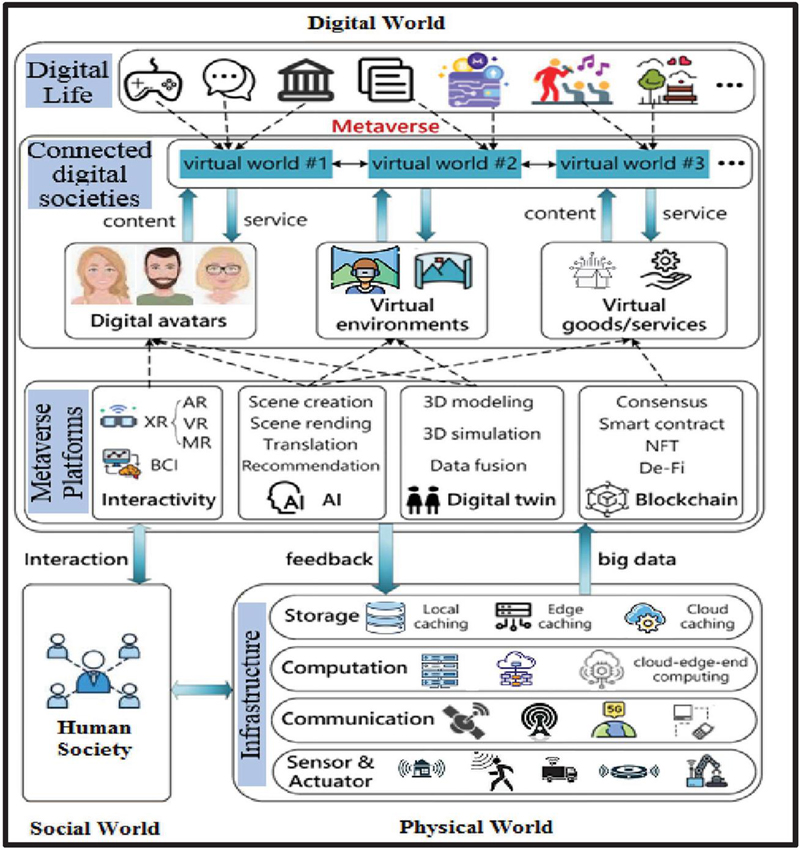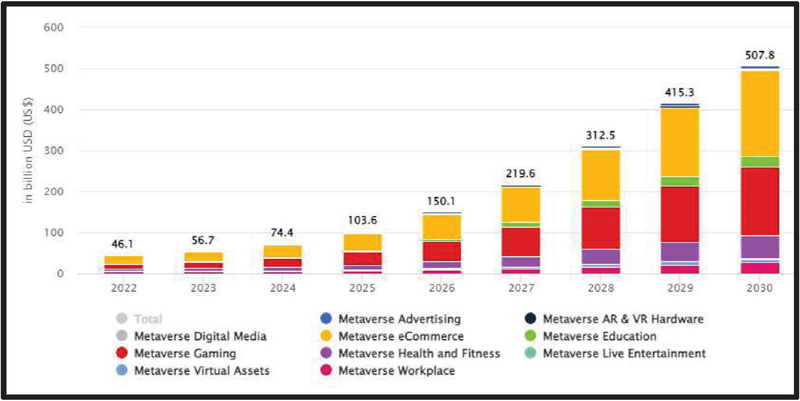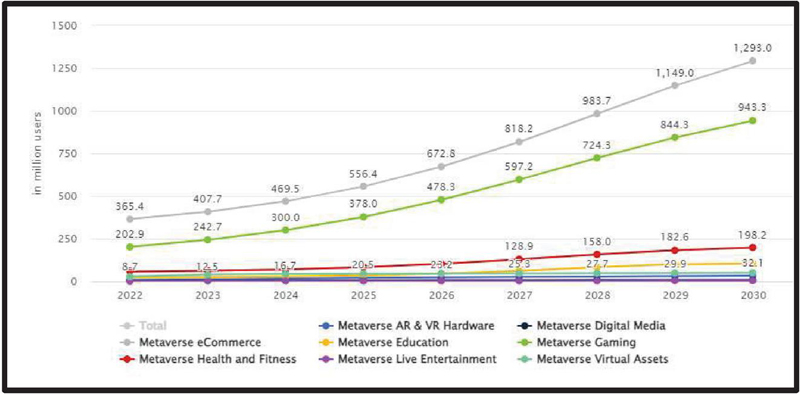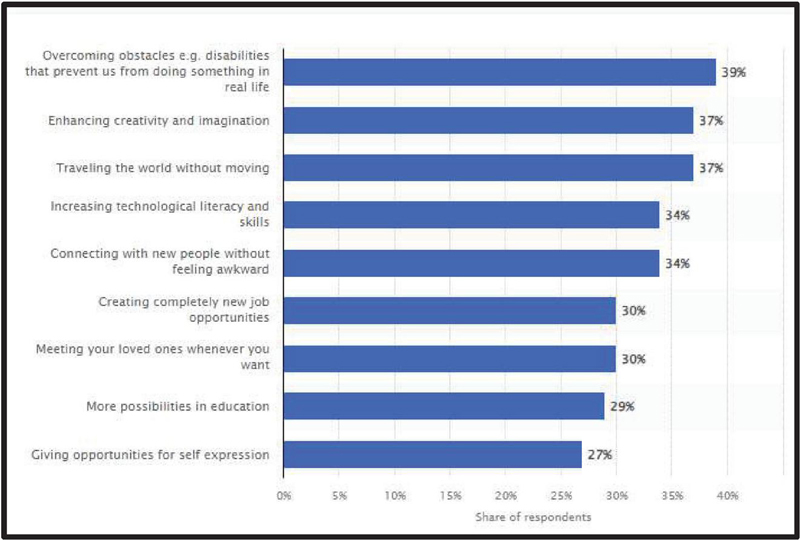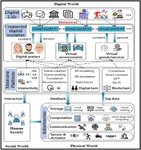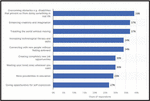Exploring Current Technologies, Applications, and Challenges in the Metaverse: A Comprehensive Survey
Sushma Malik1 and Anamika Rana2,*
1Department of Computer Applications, Institute of Innovation in Technology & Management, New Delhi, India
2Department of Computer Applications, Maharaja Surajmal Institute, New Delhi, India
E-mail: sushmamalikiitm@gmail.com; anamica.rana@gmail.com
*Corresponding Author
Received 15 March 2024; Accepted 16 April 2024
Abstract
A brand-new class of Internet applications and social media platforms called Metaverse integrates many cutting-edge technology. The word “metaverse,” which was originally coined almost 20 years ago to represent a speculative virtual environment, describes a world in which users of augmented reality technology only experience psychological effects. Virtual world-based computer games were the first use of the Metaverse. Businesses that offered gaming services were vying with one another to give customers more unique experiences. The Metaverse, a concept popularized by science fiction, is rapidly becoming a tangible reality with the advancement of virtual and augmented reality technologies. This paper presents a comprehensive survey of the current state of the Metaverse, focusing on the technologies driving its development, diverse applications across industries, and the challenges hindering its widespread adoption. Through an in-depth examination of existing literature, industry reports, and technological advancements, this survey provides insights into the evolving landscape of the Metaverse and offers perspectives on its potential impact on society, economy, and human interaction.
Keywords: Metaverse, virtual reality, augmented reality, mixed reality, blockchain, spatial computing, artificial intelligence, gaming, socializing, education, commerce, entertainment, interoperability, privacy and security, content moderation, digital ownership, accessibility.
1 Introduction
The convergence of the Internet of Things (IoT) and cyberspace has facilitated widespread connectivity between items, entities, and individuals, fostering a seamless integration of cyber, social, and intellectual domains. This integration has led to transformative changes in various human activities, including work, shopping, conferences, and entertainment, as they increasingly shift to online platforms. The COVID-19 pandemic has accelerated this trend, prompting people to spend more time in virtual spaces for communication, collaboration, and recreation [1].
Industries across the board are embracing novel development paths enabled by new economic forms, particularly in innovative sectors such as electronic games, fashion, and education. The term “Metaverse” was coined by Neal Stephenson in his 1992 novel “Snow Crash,” envisioning a virtual reality-based universe where users interact with each other and digital entities in a shared space [2].
In the aftermath of the COVID-19 pandemic, businesses, governments, and individuals worldwide have become more reliant on technology to adapt to the new reality. This increased dependence on technology has spurred advancements in digital infrastructure, remote collaboration tools, and virtual experiences, further blurring the lines between physical and digital realms. With so many companies starting to invest in the Metaverse, the extended reality (XR) ecosystem is probably going to grow very quickly in the upcoming years. Mark Zuckerberg announced in October 2021 that Facebook will become Meta and invest substantially in the Metaverse [3].
The Metaverse is a concept that refers to a collective virtual shared space, created by the convergence of virtually enhanced physical reality and physically persistent virtual reality. In simpler terms, it’s a digital universe where users can interact with each other and digital objects, often represented through avatars. The idea is to blur the lines between the physical and digital worlds, allowing for seamless integration and interaction between the two [4].
This concept is often associated with virtual reality (VR) and augmented reality (AR), as it combines elements of both to create an immersive and interactive environment. Users can explore, socialize, work, play, and even conduct business within the Metaverse [5].
One of the key aspects of the Metaverse is its persistence. Unlike traditional online games or virtual environments that reset or change over time, the Metaverse is meant to be a continuously evolving and interconnected space that retains user-generated content and experiences [6].
Figure 1 illustrates the diverse data sources that contribute to the Metaverse and its architecture, showcasing the integration of information from physical, social, and digital realms. In the Metaverse, data originates from a multitude of sources, including:
Physical World: Data from the physical world encompasses real-world environments, objects, and phenomena. This may include geographical data, sensor readings, weather information, and physical infrastructure data.
Social World: Data from the social world comprises information generated through human interactions, social networks, and online communities within the Metaverse. This includes user-generated content, social media interactions, virtual events, and community-driven activities.
Digital World: Data from the digital world encompasses virtual assets, digital interactions, and computational processes within the Metaverse. This includes data generated by virtual reality (VR) simulations, augmented reality (AR) overlays, artificial intelligence (AI) algorithms, and blockchain transactions.
Figure 1 An integrated social, physical, and digital world’s metaverse architecture [7].
By leveraging data from these diverse sources, the Metaverse architecture facilitates the creation of immersive, interconnected virtual experiences that blend elements from the physical, social, and digital worlds. This integration enables users to interact with virtual environments, engage with others, and explore new possibilities within the Metaverse ecosystem.
The forthcoming market evolution of the Metaverse is expected to experience significant expansion, with a projected Compound Annual Growth Rate (CAGR) of 34.98% and an estimated total market value of $485.8 billion by 2030 as shown in Figures 2 and 3 [8]. This projection highlights the considerable potential of the Metaverse, offering heightened social engagement and connectivity, enhanced immersive gaming experiences, and innovative prospects for education, training, and remote employment. Additionally, the creation of virtual goods and services is poised to stimulate economic advancement within this burgeoning sector.
Nonetheless, amidst these opportunities, the Metaverse also presents inherent challenges and risks. Privacy and security issues are prominent concerns, given the extensive exchange and storage of personal data in virtual realms. Moreover, the potential for addiction and adverse effects on mental well-being raises ethical considerations of considerable magnitude. Economic inequality may persist or worsen, as access to the Metaverse remains unevenly distributed, resulting in the marginalization or exclusion of certain individuals. Furthermore, the blending of boundaries between virtual and real life gives rise to philosophical and societal inquiries that merit careful examination.
Figure 2 Worldwide market size of metaverse [8].
Figure 3 Worldwide users of metaverse [8].
This study, in contrast to other ones, examines the Metaverse from a fresh technical perspective, going over everything from its fundamental ideas and technical foundations to unresolved issues. The primary contributions of this study are as follows:
• Describe the fundamental components of the Metaverse and their corresponding technical frameworks.
• Talking about the Metaverse’s application domains.
• Dealing with more Metaverse technological problems and making suggestions for further study
2 The Fundamental Components of the Metaverse
The pillars of the Metaverse revolve around connecting people, leveraging data for intelligent decision-making, optimizing processes for efficient communication and collaboration, and integrating physical and virtual objects to enable intelligent interactions and automation. These pillars collectively form the foundation of the Metaverse and shape its capabilities and functionalities. The concept described here simplifies the Metaverse as the intelligent integration of various elements: people, processes, data, and physical and virtual objects. Essentially, it envisions a world where everything is interconnected through sensors and networked connections, allowing for the seamless exchange of information and the creation of new capabilities and experiences. In more straightforward terms, the Metaverse is a highly interconnected digital universe where billions of objects, both real and virtual, are equipped with sensors to monitor and communicate their status. These objects are linked together via public or private networks, using a combination of standard and specialized protocols. This interconnectedness enables the generation of valuable insights and the facilitation of richer experiences, ultimately leading to new economic opportunities for businesses, individuals, and nations [9–11].
Figure 4 Fundamental components of the metaverse.
The fundamental components of the Metaverse encompass its core pillars, shaping its virtual landscape. The fundamental components of the Metaverse are shown in Figure 4 [12–14]:
People: This component emphasizes the importance of connecting individuals in meaningful and valuable ways within the Metaverse. It’s about fostering communication, collaboration, and interaction between people, whether through social networks, virtual meetings, or other forms of digital engagement.
Data: Data plays a crucial role in the Metaverse, as it’s used to generate insights and intelligence that drive decision-making processes. This pillar focuses on the collection, analysis, and interpretation of data to extract valuable information and inform actions within the virtual environment.
Process: Ensuring that the right information reaches the right person or machine at the right time is essential for the smooth functioning of the Metaverse. This pillar involves the design and implementation of processes and workflows that facilitate the seamless flow of information and enable efficient communication and collaboration.
Things: This component encompasses both physical and virtual devices and objects that are connected to the internet and each other within the Metaverse. These interconnected things, equipped with sensors and communication capabilities, contribute to intelligent decision-making processes and enable the automation of various tasks and processes.
3 The Technology Pillars Powering the Metaverse
The opportunities within the Metaverse span various industries, ranging from gaming and e-commerce to industrial applications such as digital twins and customer care. The six technology pillars form the foundation of the Metaverse, enabling immersive and interconnected virtual experiences that transcend traditional boundaries. As businesses and consumers embrace the potential of the Metaverse, these underlying technologies will continue to evolve and advance, driving innovation and transformation across various industries [15]. To enable these immersive experiences, there are six underlying technology pillars powering the Metaverse:
Virtual Reality (VR): VR technology creates immersive digital environments that users can explore and interact with using specialized headsets and controllers. VR enables realistic simulations and experiences within the Metaverse, enhancing engagement and immersion [16].
Augmented Reality (AR): AR overlays digital content onto the real-world environment, enriching physical surroundings with digital information and interactions. AR technology is essential for blending virtual and physical elements within the Metaverse, enabling seamless transitions between digital and real-world contexts [17].
Spatial Computing: Spatial computing technology enables the mapping and understanding of physical spaces, facilitating the integration of digital content and interactions within virtual environments. Spatial computing enhances the sense of presence and interaction within the Metaverse, enabling users to navigate and manipulate digital objects in real-time [18, 19].
Artificial Intelligence (AI): AI technologies power virtual characters, environments, and interactions within the Metaverse, enabling dynamic and responsive experiences. AI algorithms enable natural language processing, computer vision, and behavior simulation, enhancing the realism and interactivity of virtual environments [20].
Blockchain: Blockchain technology provides a decentralized and secure framework for managing digital assets, transactions, and identities within the Metaverse. Blockchain enables digital ownership, provenance tracking, and secure transactions, fostering trust and transparency in virtual economies and interactions [21, 22].
Internet of Things (IoT): IoT devices and sensors collect real-time data from physical environments, enabling the integration of real-world data into virtual experiences within the Metaverse. IoT technology enables the creation of dynamic and interactive virtual environments that reflect real-world conditions and behaviors [23, 24].
4 Applications of the Metaverse
The Metaverse represents a revolutionary frontier of digital interaction, offering a multitude of applications across diverse sectors. In gaming and entertainment, it immerses users in captivating virtual environments where they can engage in interactive adventures, attend virtual concerts, and participate in immersive storytelling experiences. Socialization and networking transcend physical limitations as virtual chat rooms, social hubs, and virtual events enable individuals to connect, collaborate, and build communities on a global scale. Education and training embrace the Metaverse’s immersive capabilities, providing learners with virtual classrooms, simulations, and training environments that offer engaging and experiential learning opportunities. E-commerce undergoes a transformation with virtual stores, digital fashion shows, and immersive shopping experiences, redefining the retail landscape and enhancing consumer engagement. Workspaces and collaboration adapt to remote work environments with virtual offices, co-working spaces, and virtual meetings, fostering seamless communication and productivity across distributed teams. In essence, the Metaverse represents a transformative force that transcends traditional boundaries, unlocking innovation and reshaping human experiences across a myriad of domains [13, 25, 26]. The Metaverse offers a myriad of benefits on a global scale, revolutionizing various aspects of human interaction, entertainment, and commerce. Some of the leading benefits are represent in Figure 5.
Figure 5 Leading benefits of the metaverse worldwide [27].
Online video conference: In the wake of the COVID-19 pandemic, traditional face-to-face workplace meetings have shifted to virtual platforms, such as online video conferences, to ensure safety and continuity. However, this transition often comes with limitations, as online communication lacks the immediacy and nuances of in-person interaction. Body language, a crucial aspect of effective communication, is often lost in online settings, leading to potential misunderstandings and inefficiencies in collaboration. Moreover, delays in communication and the absence of physical presence can hinder effective cooperation and provide inaccurate feedback. In contrast, the Metaverse offers a promising solution to these challenges by enabling users to interact through sociable avatars within immersive virtual environments. In the Metaverse, individuals can engage in virtual meetings where body language and eye contact can be used to convey emotions and intentions, enhancing communication and collaboration. By leveraging the immersive nature of the Metaverse, telecommuting experiences can be significantly improved, allowing coworkers to connect and collaborate seamlessly from diverse perspectives, regardless of physical distance [28–30].
Real Estate and Virtual Property: Real estate, encompassing land and structures usable for construction, residency, investment, rental, sale, and acquisition, parallels its real-world counterpart within the Metaverse. Moreover, factors influencing property values in physical spaces, like location, amenities, and accessibility, similarly influence value in virtual environments. The virtual platform underscores to users the scarcity of available virtual land, which is offered through auctions and exchanged for Non-Fungible Tokens (NFTs).
Gaming and Entertainment: Gaming and entertainment stand as the forefront of the Metaverse’s potential applications, offering a gateway to unparalleled immersive experiences. Within this digital realm, players are transported into vibrant and dynamic virtual worlds, where they embark on thrilling adventures and engage in rich interactive experiences. The Metaverse transcends the limitations of traditional gaming platforms, enabling users to interact with fellow players in real-time, collaborate on quests, and forge lasting friendships in captivating virtual environments. From exploring fantastical landscapes to participating in epic battles, the possibilities for adventure are endless. Through the Metaverse, gaming and entertainment are elevated to new heights, revolutionizing the way players engage with and experience digital entertainment in an ever-evolving and boundless virtual universe [31, 32].
Social Networking: In the ever-evolving landscape of social networking, the Metaverse emerges as a transformative platform offering boundless opportunities for connection and interaction. Within this immersive digital realm, users transcend physical boundaries to convene in virtual spaces teeming with possibilities. Whether attending virtual events, concerts, or simply engaging in shared activities, individuals have the freedom to interact with others in dynamic and vibrant environments. These virtual encounters serve as catalysts for fostering meaningful connections and relationships, transcending geographical constraints and enriching social experiences. As the Metaverse continues to evolve, it heralds a new era of social networking, characterized by unprecedented immersion, engagement, and connectivity in a digital landscape ripe with endless possibilities [33, 34].
Education and Training: The Metaverse stands poised to revolutionize education and training, ushering in a new era of immersive and interactive learning experiences. With its vast potential, students can transcend the confines of traditional classrooms to explore virtual environments tailored to their educational needs. These virtual classrooms serve as dynamic hubs where students engage in simulations, experiments, and hands-on activities, fostering experiential learning in ways previously unimaginable. Through the integration of cutting-edge technologies, such as augmented reality (AR) and virtual reality (VR), educational content comes to life, captivating learners and deepening their understanding of complex concepts. By leveraging the capabilities of the Metaverse, educators can unlock innovative teaching methodologies, empowering students to actively participate in their learning journey and cultivate critical thinking skills essential for success in the digital age [31, 35, 36].
Virtual Meetings and Collaboration: As remote work and distributed teams become increasingly prevalent, the Metaverse emerges as a transformative solution for virtual meetings and collaboration. Within this digital realm, users transcend geographical constraints to convene in virtual spaces, fostering seamless collaboration and communication. Real-time project collaboration is facilitated, enabling teams to work together on tasks and initiatives regardless of their physical locations. Productive discussions and brainstorming sessions flourish as participants engage in immersive interactions, leveraging the diverse capabilities of the Metaverse. By transcending physical limitations, the Metaverse empowers organizations to harness the collective expertise of their teams, driving innovation and productivity in a dynamic and interconnected virtual environment [37, 38].
Healthcare and Therapy: The integration of the Metaverse into healthcare presents transformative opportunities to enhance the accuracy and efficiency of surgical treatments and patient care. By leveraging advanced technologies such as augmented reality (AR), healthcare professionals can access real-time patient data overlaid onto their field of view through AR headsets, complementing pre-operative images from MRI, CT scans, and 3D imaging. This immersive visualization enables surgeons to make more informed decisions and perform procedures with greater precision, ultimately improving patient outcomes. Additionally, the implementation of the Metaverse facilitates remote patient monitoring and telemedicine applications, which have become increasingly vital in the post-COVID-19 era. Through virtual 3D clinics and telehealth platforms, patients and healthcare providers can engage in virtual consultations, monitor vital signs, and manage chronic conditions from the comfort of their homes. The Metaverse revolutionizes healthcare delivery by offering innovative solutions that streamline workflows, expand access to care, and empower both patients and providers to collaborate in virtual environments [39, 40].
Commerce and Retail: In the dynamic landscape of commerce and retail, the emergence of the Metaverse offers a groundbreaking avenue for retailers to redefine the shopping journey. Leveraging this immersive digital realm, retailers can transcend traditional boundaries, introducing customers to a novel shopping experience. Through meticulously crafted virtual stores, shoppers navigate immersive environments, exploring product offerings with unprecedented ease and depth. The integration of augmented reality (AR) and virtual reality (VR) technologies further elevates this experience, enabling customers to virtually try on clothing and interact with products in lifelike simulations. By bridging the gap between physical and virtual realms, the Metaverse empowers customers to make informed purchase decisions, fostering engagement and satisfaction. This paradigm shift in commerce and retail heralds a new era of consumer interaction, characterized by innovation, interactivity, and boundless possibilities [41, 42].
Military: The military sector has embraced the potential of the Metaverse, leveraging virtual reality (VR) and augmented reality (AR) technologies to enhance various military applications. Among these innovations, Tactical Augmented Reality (TAR) has emerged as a notable example, showcasing the transformative capabilities of Metaverse technology in military operations. Similar to night vision goggles, TAR offers advanced features that provide soldiers with critical situational awareness, including the real-time locations of comrades and enemies. By overlaying digital information onto the physical environment, TAR equips soldiers with invaluable intelligence, enabling them to make informed decisions and navigate complex terrain with precision. In practice, TAR has proven to be a highly effective alternative to conventional portable GPS devices and headsets, offering enhanced functionality and usability in military operations. As the Metaverse continues to evolve, its integration into military applications holds promise for further advancements in enhancing situational awareness and improving operational effectiveness on the battlefield [43–45].
5 Challenges and Limitations
The adoption and implementation of the Metaverse also come with several challenges and limitations that need to be addressed [15, 46–48]:
Interoperability Challenges: As the Metaverse evolves, various platforms and technologies may lack interoperability, making it difficult for users to seamlessly interact and transfer assets between different virtual environments.
Privacy and Security Concerns: The vast amount of personal data generated within the Metaverse raises concerns about privacy and security. Protecting user information, preventing unauthorized access, and ensuring data security are critical considerations.
Content Moderation Issues: User-generated content within the Metaverse may pose challenges related to content moderation, such as monitoring and managing inappropriate or harmful content, ensuring a safe and inclusive virtual environment.
Digital Ownership Dilemmas: Determining ownership rights and managing digital assets within the Metaverse can be complex. Issues related to intellectual property, digital rights management, and ownership verification need to be addressed to ensure fair and transparent transactions.
Accessibility Considerations: Making the Metaverse accessible to individuals with disabilities and diverse backgrounds is essential for creating inclusive virtual experiences. Designing interfaces, content, and interactions that accommodate different needs and abilities is crucial for ensuring equal access and participation.
6 Future Directions and Implications of Metaverse
The future of the Metaverse holds immense potential for reshaping digital interactions and experiences. Emerging trends such as advancements in virtual reality (VR), augmented reality (AR), artificial intelligence (AI), and blockchain technology are expected to drive innovation within the Metaverse. This evolution could lead to more immersive and interconnected virtual environments, revolutionizing how we communicate, collaborate, and engage with digital content. However, alongside these exciting opportunities come important considerations regarding societal and economic impacts, as well as ethical and regulatory concerns. The widespread adoption of the Metaverse could democratize access to information and opportunities, but it also raises questions about privacy, data security, digital identity, and content moderation. Regulatory frameworks will need to evolve to address these challenges and ensure that the Metaverse remains a safe and inclusive environment for all users [49–52].
Emerging Trends and Innovations: The Metaverse is expected to continue evolving rapidly, driven by emerging trends and innovations in technology. Some key trends to watch include advancements in virtual reality (VR), augmented reality (AR), artificial intelligence (AI), and blockchain technology. These innovations will likely lead to more immersive and interactive experiences within the Metaverse, enabling new forms of communication, collaboration, and entertainment. Additionally, we may see the integration of the Internet of Things (IoT) and 5G connectivity, further enhancing the connectivity and capabilities of the Metaverse.
Potential Impact on Society and Economy: The widespread adoption of the Metaverse could have profound implications for society and the economy. On the one hand, it has the potential to democratize access to information and opportunities, breaking down geographical barriers and enabling people from diverse backgrounds to connect and collaborate in virtual spaces. This could lead to new forms of education, healthcare, and social interaction. However, there are also concerns about the potential for the Metaverse to exacerbate existing inequalities, particularly if access to virtual spaces and technologies is not equitable. Additionally, the Metaverse could disrupt traditional industries and business models, creating new economic opportunities while also posing challenges for regulation and governance.
Ethical and Regulatory Considerations: As the Metaverse becomes more integrated into our daily lives, there are important ethical and regulatory considerations that need to be addressed. These include issues related to privacy and data security, digital identity and authentication, intellectual property rights, and content moderation. There are also concerns about the potential for misinformation, online harassment, and other forms of harmful behavior within virtual spaces. Regulatory frameworks will need to evolve to address these challenges and ensure that the Metaverse remains a safe and inclusive environment for all users. Additionally, there will be ongoing debates about the role of government, technology companies, and other stakeholders in shaping the future of the Metaverse and ensuring that it serves the public interest.
7 Conclusion
The Metaverse is an emerging innovation that amalgamates various cutting-edge technologies such as virtual reality, augmented reality, blockchain, artificial intelligence, Internet of Things, and telecommunication. This convergence creates a highly advanced platform promising users immersive and personalized experiences. Businesses are increasingly recognizing the potential of the Metaverse and are investing in its development to reshape and enhance customer experiences. As the Metaverse continues to evolve, it is poised to revolutionize how people interact, work, play, and connect in the digital realm.
The advent of the Metaverse introduces a novel concept where users can cultivate virtual identities alongside their real-world personas, crafting avatars that represent them in immersive digital environments. In this virtual realm, individuals can attain social status and experiences that may surpass what’s achievable in reality, freely expressing themselves through customizable avatars and donning attire limited only by their imagination.
This technological paradigm shift is not only transforming social dynamics but also exerting significant influence on the global economy. As technology advances, new professions are emerging to meet the demands of this evolving landscape, shaping the economic landscape in profound ways.
As the Metaverse continues to develop, it is poised to further blur the lines between the digital and physical worlds, revolutionizing how individuals engage with technology, society, and commerce on a global scale.
References
[1] N. G. Narin, “A content analysis of the metaverse articles,” J. Metaverse, vol. 1, no. 1, pp. 17–24, 2021.
[2] Y. Cai, J. Llorca, A. M. Tulino, and A. F. Molisch, “Compute-and data-intensive networks: The key to the metaverse,” in 2022 1st International Conference on 6G Networking (6GNet), 2022, pp. 1–8.
[3] M. Damar, “Metaverse shape of your life for future: A bibliometric snapshot,” J. Metaverse, vol. 1, no. 1, pp. 1–8, 2021.
[4] H. Ning et al., “A Survey on the Metaverse: The State-of-the-Art, Technologies, Applications, and Challenges,” IEEE Internet Things J., 2023.
[5] K. Laeeq and E. Sciences, “Metaverse: Why, How and What,” no. February, 2022.
[6] S. Salcini, “Metaverse: Technology of the Future,” pp. 55–63, 2022.
[7] H. Zhang, S. Lee, Y. Lu, X. Yu, and H. Lu, “A Survey on Big Data Technologies and Their Applications to the Metaverse: Past, Current and Future,” Mathematics, vol. 11, no. 1, 2023, doi: 10.3390/math11010096.
[8] Statista, “Metaverse - Worldwide |Statista Market Forecast,” 2023. https://www.statista.com/outlook/amo/metaverse/worldwide (accessed Mar. 15, 2024).
[9] A. Banafa, “The Metaverse: A Different Perspective | OpenMind,” 2022. https://www.bbvaopenmind.com/en/technology/digital-world/the-metaverse-a-different-perspective/ (accessed May 13, 2023).
[10] H. Ning et al., “A Survey on Metaverse: the State-of-the-art, Technologies, Applications, and Challenges,” 2021, [Online]. Available: http://arxiv.org/abs/2111.09673.
[11] F. Shi et al., “A new technology perspective of the Metaverse: Its essence, framework and challenges,” Digit. Commun. Networks, 2023, doi: 10.1016/j.dcan.2023.02.017.
[12] A. Ramadhan, S. Pradono Suryodiningrat, and I. Mahendra, “The fundamentals of metaverse: a review on types, components and opportunities,” J. Inf. Organ. Sci., vol. 47, no. 1, pp. 153–165, 2023.
[13] S.-M. Park and Y.-G. Kim, “A metaverse: Taxonomy, components, applications, and open challenges,” IEEE access, vol. 10, pp. 4209–4251, 2022.
[14] Y. Wang et al., “A survey on metaverse: Fundamentals, security, and privacy,” IEEE Commun. Surv. Tutorials, 2022.
[15] M. Xu et al., “A full dive into realizing the edge-enabled metaverse: Visions, enabling technologies, and challenges,” IEEE Commun. Surv. Tutorials, vol. 25, no. 1, pp. 656–700, 2022.
[16] N. Xi, J. Chen, F. Gama, M. Riar, and J. Hamari, “The challenges of entering the metaverse: An experiment on the effect of extended reality on workload,” Inf. Syst. Front., vol. 25, no. 2, pp. 659–680, 2023.
[17] M. A. I. Mozumder, M. M. Sheeraz, A. Athar, S. Aich, and H.-C. Kim, “Overview: Technology roadmap of the future trend of metaverse based on IoT, blockchain, AI technique, and medical domain metaverse activity,” in 2022 24th International Conference on Advanced Communication Technology (ICACT), 2022, pp. 256–261.
[18] K. Valaskova, J. Horak, and S. Bratu, “Simulation modeling and image recognition tools, spatial computing technology, and behavioral predictive analytics in the metaverse economy,” Rev. Contemp. Philos., vol. 21, pp. 239–255, 2022.
[19] N. Morley, “Perception and Cognition Algorithms, Simulation Modeling and Data Visualization Tools, and Spatial Computing and Immersive Technologies in the Metaverse Interactive Environment,” Anal. Metaphys., no. 21, pp. 244–260, 2022.
[20] L. Chang et al., “6G-enabled edge AI for Metaverse: Challenges, methods, and future research directions,” J. Commun. Inf. Networks, vol. 7, no. 2, pp. 107–121, 2022.
[21] M. Ersoy and R. Gürfidan, “Blockchain-based asset storage and service mechanism to metaverse universe: Metarepo,” Trans. Emerg. Telecommun. Technol., vol. 34, no. 1, p. e4658, 2023.
[22] T. R. Gadekallu et al., “Blockchain for the metaverse: A review,” arXiv Prepr. arXiv2203.09738, 2022.
[23] Y. Han et al., “A dynamic hierarchical framework for IoT-assisted digital twin synchronization in the metaverse,” IEEE Internet Things J., vol. 10, no. 1, pp. 268–284, 2022.
[24] S. E. Bibri, “The metaverse as a virtual model of platform urbanism: its converging AIoT, XReality, neurotech, and nanobiotech and their applications, challenges, and risks,” Smart Cities, vol. 6, no. 3, pp. 1345–1384, 2023.
[25] J. N. Njoku, C. I. Nwakanma, G. C. Amaizu, and D. Kim, “Prospects and challenges of Metaverse application in data-driven intelligent transportation systems,” IET Intell. Transp. Syst., vol. 17, no. 1, pp. 1–21, 2023.
[26] R. Chengoden et al., “Metaverse for healthcare: a survey on potential applications, challenges and future directions,” IEEE Access, vol. 11, pp. 12765–12795, 2023.
[27] A. Petrosyan, “Benefits of the metaverse 2021 | Statista,” 2022. https://www.statista.com/statistics/1285117/metaverse-benefits/ (accessed Mar. 15, 2024).
[28] D. Yoon and A. Oh, “Design of Metaverse for Two-Way Video Conferencing Platform Based on Virtual Reality.,” J. Inf. Commun. Converg. Eng., vol. 20, no. 3, 2022.
[29] J. Tu, “Meetings in the metaverse: Exploring online meeting spaces through meaningful interactions in gather. town.” University of Waterloo, 2022.
[30] S. Sunardi, A. Ramadhan, E. Abdurachman, A. Trisetyarso, and M. Zarlis, “Acceptance of augmented reality in video conference based learning during COVID-19 pandemic in higher education,” Bull. Electr. Eng. Informatics, vol. 11, no. 6, pp. 3598–3608, 2022.
[31] B. Kye, N. Han, E. Kim, Y. Park, and S. Jo, “Educational applications of metaverse: possibilities and limitations,” J. Educ. Eval. Health Prof., vol. 18, 2021.
[32] X. Niu and W. Feng, “Immersive entertainment environments-from theme parks to metaverse,” in International Conference on Human-Computer Interaction, 2022, pp. 392–403.
[33] Y. Huang and Y. Jin, “Research on the Impact of the Metaverse on the Future of Social Networking,” J. Educ. Humanit. Soc. Sci., vol. 5, pp. 198–204, 2022.
[34] R. Cheng, N. Wu, S. Chen, and B. Han, “Reality check of metaverse: A first look at commercial social virtual reality platforms,” in 2022 IEEE conference on virtual reality and 3D user interfaces abstracts and workshops (VRW), 2022, pp. 141–148.
[35] X. Zhang and Y. Chen, “The metaverse in education: Definition, framework, features, potential applications, challenges, and future research topics,” Front. Psychol., vol. 13, p. 1016300, 2022.
[36] S. K. Jagatheesaperumal, K. Ahmad, A. Al-Fuqaha, and J. Qadir, “Advancing education through extended reality and internet of everything enabled metaverses: applications, challenges, and open issues,” IEEE Trans. Learn. Technol., 2024.
[37] S. Suzuki et al., “Virtual Experiments in Metaverse and their Applications to Collaborative Projects: The framework and its significance,” Procedia Comput. Sci., vol. 176, pp. 2125–2132, 2020.
[38] G. H. Popescu, C. F. Ciurlãu, C. I. Stan, C. Bãcãnoiu, and A. Tãnase, “Virtual workplaces in the metaverse: immersive remote collaboration tools, behavioral predictive analytics, and extended reality technologies,” Psychosociological Issues Hum. Resour. Manag., vol. 10, no. 1, pp. 21–34, 2022.
[39] G. Bansal, K. Rajgopal, V. Chamola, Z. Xiong, and D. Niyato, “Healthcare in metaverse: A survey on current metaverse applications in healthcare,” Ieee Access, vol. 10, pp. 119914–119946, 2022.
[40] A. Musamih et al., “Metaverse in healthcare: Applications, challenges, and future directions,” IEEE Consum. Electron. Mag., 2022.
[41] B. Shen, W. Tan, J. Guo, L. Zhao, and P. Qin, “How to promote user purchase in metaverse? A systematic literature review on consumer behavior research and virtual commerce application design,” Appl. Sci., vol. 11, no. 23, p. 11087, 2021.
[42] E. Swilley, “Moving virtual retail into reality: Examining metaverse and augmented reality in the online shopping experience,” in Looking forward, looking back: Drawing on the past to shape the future of marketing: Proceedings of the 2013 World marketing congress, 2015, pp. 675–677.
[43] T. Zhao, L. Wu, J. Tao, and S. Li, “Metaverse Concept and Its Military Application,” J. Syst. Simul., vol. 35, no. 7, pp. 1405–1420, 2023.
[44] R. Solly and J. McArdle, “Unlocking the Military Potential of the Metaverse,” [2023-05-22]. https://www.sto.nato.int/publications/STO\%20Meeting\%20Proceedings/STO-MP-MSG-197/MP-MSG-197-27.pdf. 2022.
[45] M. Blowers, N. Jaimes, and J. Williams, “Benefits and challenges of a military metaverse,” in Disruptive Technologies in Information Sciences VII, 2023, vol. 12542, pp. 171–180.
[46] F. Shi et al., “A new technology perspective of the Metaverse: Its essence, framework and challenges,” Digit. Commun. Networks, 2023.
[47] L.-H. Lee et al., “All one needs to know about metaverse: A complete survey on technological singularity, virtual ecosystem, and research agenda,” arXiv Prepr. arXiv2110.05352, 2021.
[48] A. Athar, S. M. Ali, M. A. I. Mozumder, S. Ali, and H.-C. Kim, “Applications and possible challenges of healthcare metaverse,” in 2023 25th International Conference on Advanced Communication Technology (ICACT), 2023, pp. 328–332.
[49] J. Cho, M. C. tom Dieck, and T. Jung, “What is the metaverse? Challenges, opportunities, definition, and future research directions,” in International XR Conference, 2022, pp. 3–26.
[50] A. Koohang et al., “Shaping the metaverse into reality: a holistic multidisciplinary understanding of opportunities, challenges, and avenues for future investigation,” J. Comput. Inf. Syst., vol. 63, no. 3, pp. 735–765, 2023.
[51] I. Yaqoob, K. Salah, R. Jayaraman, and M. Omar, “Metaverse applications in smart cities: Enabling technologies, opportunities, challenges, and future directions,” Internet of Things, p. 100884, 2023.
[52] H. Sami et al., “The metaverse: Survey, trends, novel pipeline ecosystem & future directions,” arXiv Prepr. arXiv2304.09240, 2023.
Biographies

Sushma Malik is working as Associate Professor at Institute of Innovation in Technology and Management (IINTM), Affiliated to GGSIPU, New Delhi. She has been sharing her experience and expertise in the field of academics for the past 13 years. She has a strong inclination towards both teaching and research work. Her areas of interest include Data mining, E-commerce and software engineering. She has numerous research papers published in national as well as international journals. In addition, she has also presented research papers in conferences and has attended multiple seminars. She has authored books on E-Commerce and Digital Marketing for BBA/BCOM and BCA students of GGSIPU. She also play a role of Reviewer in a number of Journals (Listed in Resume), and three Patents.

Anamika Rana currently serves as an Associate Professor at the Maharaja Surajmal Institute, affiliated with GGSIPU, New Delhi. With over 14 years of experience in academia, she has demonstrated a strong commitment to both teaching and research. Her academic contributions extend beyond the classroom, with numerous research papers published in esteemed national and international journals. Additionally, she actively participates in academic conferences, presenting her research findings and engaging in scholarly discourse.
Journal of Graphic Era University, Vol. 12_1, 105–124.
doi: 10.13052/jgeu0975-1416.1217
© 2024 River Publishers
